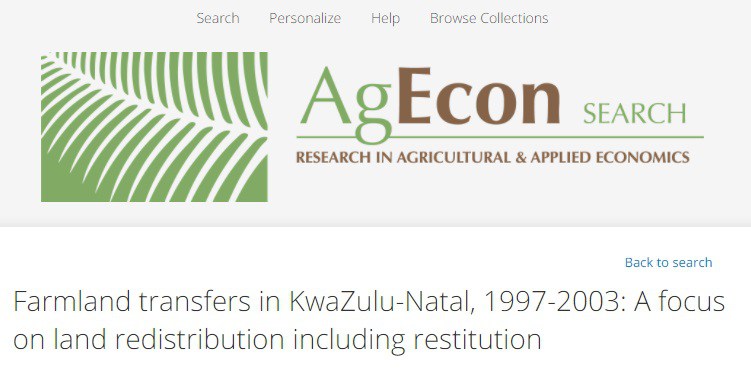AgEcon Search: Research in Agricultural and Applied Economics collects, indexes, and electronically distributes full text copies of scholarly research in the broadly defined field of agricultural economics including sub disciplines such as agribusiness, food supply, natural resource economics, environmental economics, policy issues, agricultural trade, and economic development.
The majority of items in AgEcon Search are working papers, conference papers, and journal articles, although other types such as books chapters and government documents are included. AgEcon Search will serve as the permanent archive for this literature and encourages authors and organizations to use this electronic library as the storehouse for additional appropriate scholarly electronic works.
AgEcon Search is co-sponsored by the Department of Applied Economics and the University Libraries at University of Minnesota and the Agricultural and Applied Economics Association.
The site has received encouragement and financial support from:
Agricultural Economics Reference Organization
Agricultural and Applied Economics Association
European Association of Agricultural Economists
Farm Foundation
International Association of Agricultural Economists
USDA Economic Research Service
AgEcon Search is part of the University of Minnesota's Digital Conservancy, which provides stewardship, reliable long-term access, and broad dissemination of the digital scholarly and administrative works of the University of Minnesota faculty, departments, centers and offices.
Papers and articles downloaded from AgEcon Search may be used for non-commercial purposes and personal study only. No other use, including posting to another Internet site, is permitted without permission from the copyright owner, or as allowed under the provisions of Fair Use, U.S. Copyright Act, Title 17 U.S.C.
AgEcon Search does not hold the copyright to articles, working papers, conference papers, or other materials available in the database. Copyrights may be held by any of the following: individual authors, multiple authors, organizations, institutions, or publishers.
History
AgEcon Search began in 1995 as an experiment to see if it were possible to use the internet to archive, index and deliver on demand, full text working papers produced by university agricultural economics departments. The first papers were from agricultural economics departments at Minnesota and Wisconsin. These early papers predated the World Wide Web and were mounted on a GOPHER server in WordPerfect format. The project was (and still is) a cooperative project of the University of Minnesota Libraries, the Department of Applied Economics at the University of Minnesota and the Agricultural and Applied Economics Association (AAEA). The Farm Foundation and the Economic Research Service of the U.S. Department of Agriculture provided financial support in the beginning of the project. Patricia Rodkewich and Louise Letnes managed AgEcon Search until Patricia's retirement in 2001, when Julie Kelly joined the AgEcon Search team. Erik Biever also served on the original AgEcon Search team, providing valued technical services and guidance. The members of the Agricultural Economics Reference Organization endorsed the efforts of AgEcon Search early on and have been instrumental in expanding the use of AgEcon Search in their respective institutions.
Since its inception AgEcon Search has operated as a distributed network, with each institution designating a member of their organization to submit papers on their behalf. With this model, costs for maintaining the system were kept low and institutions do not have to pay membership fees for participation. In the cases where an institution had no central person to act as the network member, a fee has been charged for AgEcon Search staff to submit papers. The first organization to choose this option was the Agricultural and Applied Economics Association, which since 1997 has been contracting with AgEcon Search to post its annual conference papers.
Members:
Resources
Displaying 1 - 5 of 377Farmland transfers in KwaZulu-Natal, 1997-2003: A focus on land redistribution including restitution
Census surveys of land transactions show that 203,300 hectares of KwaZulu-Natal’s commercial farmland transferred to previously disadvantaged South Africans over the period 1997-2003. This represents 3.8 per cent of the farmland originally available for redistribution in 1994. The annual rate of land redistribution in the province fell from a peak of 1.06 per cent in 2002 to 0.41 per cent
Migration and land rental as risk response in rural China
Households in developing countries take various actions to smooth income or consumption as a means of managing or responding to risk. This paper examines migration and land rental market participation as responses to risk in rural China.
The authors show that over the last 30 years, there have been significant reforms in China, which have increased labour mobility and the functioning of rural land markets. The authors emphasise that while limitations still remain, the reforms have to date increased the efficiency of the allocation of these important factors of production.
Migration and land rental as risk response in rural China
Households in developing countries take various actions to smooth income or consumption as a means of managing or responding to risk. This paper examines migration and land rental market participation as responses to risk in rural China. The authors show that over the last 30 years, there have been significant reforms in China, which have increased labour mobility and the functioning of rural land markets. The authors emphasise that while limitations still remain, the reforms have to date increased the efficiency of the allocation of these important factors of production.
Global biofuel expansion and the demand for Brazilian land: intensification versus expansion
The rapid increase in global biofuel production and consumption, particularly of ethanol, has an associated derived demand for crops to produce the necessary feedstock. This working paper assess the implications of global biofuel expansion on Brazilian land usage at the regional level.The document reveals that most of the expansion in global ethanol consumption outside the US is met by Brazilian ethanol production.
The global supply and demand for agricultural land in 2050: a perfect storm in the making?
The number of people which the world must feed is expected to increase by 50% during the first half of this century, but will the world’s agricultural resource base be up to the task of meeting the diverse demands being placed on it?





